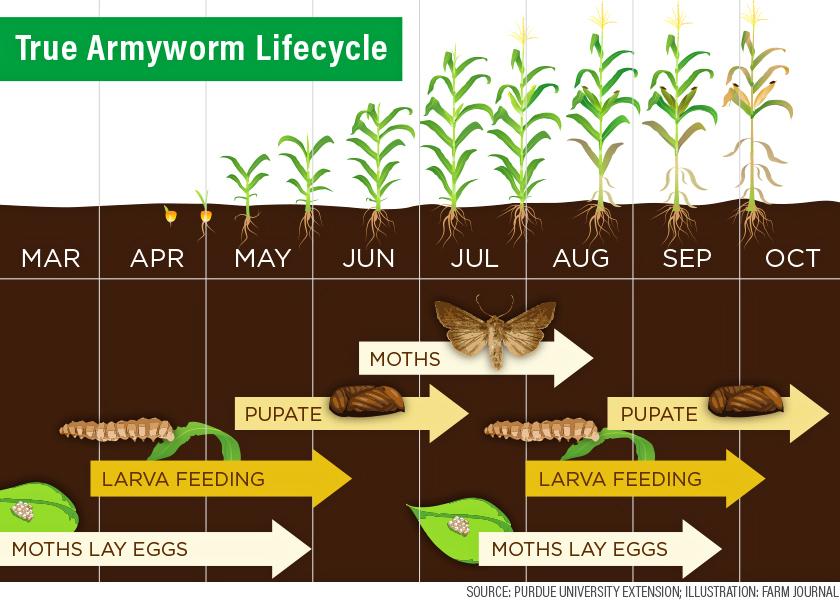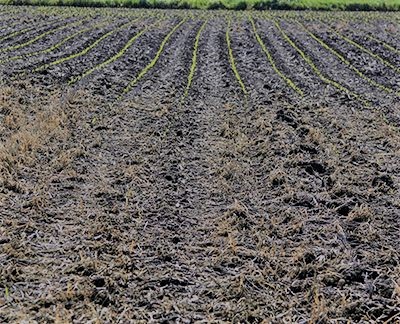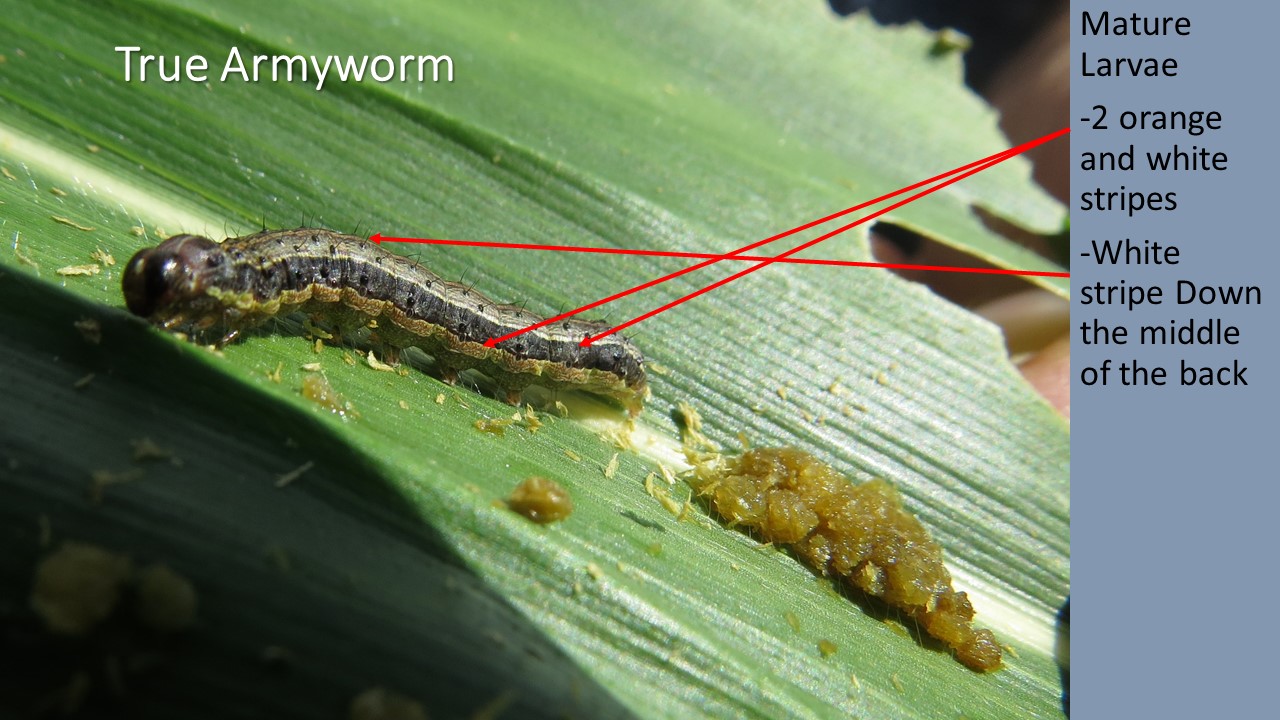Is A Double Whammy of True Armyworm Underway?

If you’ve ever seen the results of the true armyworm at work, you know how the pest got its name. The larvae work like an army marching their way across fields feeding on crops – preferably those in the grass family.
 Corn and wheat are grass crops the pest will eagerly invade and ravage. The photo here shows how true armyworm decimated corn seedlings in part of an Iowa field (Photo is by Adam Varenhorst, Iowa State University.).
Corn and wheat are grass crops the pest will eagerly invade and ravage. The photo here shows how true armyworm decimated corn seedlings in part of an Iowa field (Photo is by Adam Varenhorst, Iowa State University.).
Pasture grasses and forages – even your home lawn – are also on the menu.
And that’s not all. Under hunger stress, if grasses aren’t available, the true armyworm will adjust and feed on what is readily available such as soybeans and other legumes.
Homegrown TAW And Newcomers Unite
Because its migration patterns are sporadic and cyclic from year-to-year, it can be difficult for agronomists to predict much in advance as to whether true armyworm (TAW) is going to be a problem farmers need to address in a given season.
This year, it’s looking like TAW could be a significant insect problem in parts of the Midwest for at least two reasons, according to Ken Ferrie, Farm Journal Field Agronomist.
For one thing, large numbers of moths are moving in from warmer southern climes into his area of central Illinois.
Secondly, Ferrie says a significant population of TAW overwintered in central Illinois, thanks to mild winter weather this year.
He and his agronomic team at Crop-Tech Consulting are using pheromone traps to capture the pest now and are finding significant numbers in local farmers’ wheat fields.
“Seventy, 80, 90 true armyworm are not uncommon to find in a trap. But here lately, we're well over 200 in some of these traps, so this tells us the pressure is high,” Ferrie says.
“Right now, the risk is true armyworm will defoliate the wheat crop – cutting off the plant heads – but it could get a little rough in corn here, too,” he adds. “It’s a situation we’re going to really need to pay attention to.”
Ferrie lays out the problem he’s watching unfurl in central Illinois fields – as corn and soybean planting season ratchets up – in his latest Agronomic Minute video. Watch it here:
Four States Have Already Reported TAW
While Ferrie reports seeing high numbers of TAW in central Illinois, next door in Indiana, the pest is also making its presence known.
Last Thursday (April 20), Purdue University Extension Entomologist John Obermeyer reports TAW has been found and trapped in at least eight locations. In trap numbers reported last week, the three highest counts were 179, 197 and 216 TAW. The three lowest counts were 0, 39 and 51. See Obermeyer’s weekly overview for 2023 here.
A number of other universities have traps in place and are reporting weekly on the results. Here’s a brief sampling:
Iowa State University reports finding only 46 true armyworm around the state, according to Ashley Dean, education Extension specialist and coordinator of the Iowa Moth Trapping Network.
Michigan State University reported 72 TAW were trapped in southwest Michigan, with 69 of those in one trap, says Eric Anderson, field crops educator
University of Missouri Extension reported no sightings in traps last week across Missouri.
Corn Crops Are At Risk
As populations of true armyworm moths migrate into the Midwest, they are looking for green vegetation in fields, along field margins and roadside ditches where they can lay eggs. Emerging early-season weeds, grass cover crops and grassy vegetation are desirable places for egg laying.
A week after the moth lays eggs, the larvae begin to hatch and develop. Larvae range in size from one-eighth to 1 ½ inches long. The young larvae are pale green to brownish while still small and have smooth, cylindrical bodies. Mature larvae are smooth and marked with two orange, white-bordered strips on each side.
The larvae are voracious feeders and start munching on the vegetation where they hatched. When the original host plants are no longer available (defoliated or terminated by herbicide), larvae move to adjacent wheat, corn and other crops, according to Erin Hodgson and Adam Sisson, Extension specialists at Iowa State University.
True armyworm likes to hide during the day and feed at night, so scouting should occur at dusk or dawn, and/or on cloudy days, recommends Ohio State University Extension.
Treatment Options And Timing
For corn seedlings (VE to V2), Hodgson and Sisson recommend foliar insecticide applications occur when 10% or more of corn plants are injured and larvae are less than ¾-inch long.
 When corn is at V7 to V8, treatment should be considered only if larvae are ¾-inch long with more than eight larvae per plant and 25% of leaf area has been removed. Larvae this size are expected to feed for another week or so and may cause more injury and warrant a rescue insecticide treatment. (Photo above is from Cornell University.)
When corn is at V7 to V8, treatment should be considered only if larvae are ¾-inch long with more than eight larvae per plant and 25% of leaf area has been removed. Larvae this size are expected to feed for another week or so and may cause more injury and warrant a rescue insecticide treatment. (Photo above is from Cornell University.)
If you use Bt traits, don’t assume they will provide adequate protection against true armyworm like they might against fall armyworm, cautions Brent Tharp, technical product manager for Wyffels Hybrids.
They are not the same pest but, instead, are two distinctly different insects.
“True armyworm is a pest of late spring and summer, while fall armyworm is typically present late summer or fall,” Tharp says in an online article.
“Nearly all Bt corn hybrids either control or suppress fall armyworm, but not true armyworm. Traits that contain the Viptera gene, like Trecepta do exhibit control of true armyworm,” he adds.
Likewise, insecticidal seed treatments may or may not be effective against TAW, according to Andy Michel, Curtis Young and Kelley Tilmon, Ohio State University, in an online article.
"Insecticidal seed treatments may offer some control but can be overwhelmed with high populations," they says. "Plus, insecticidal seed treatments last only about four to six weeks after planting."
Hurry Up And Wait...Proactively
No one can say at this point whether TAW will contribute to significant yield losses this season. Talk with other farmers, Extension, seed company agronomists and consultants to stay on top of this pest and others.
Most of all, appoint someone to be your official pest boss to scout and be aware of what’s happening in your fields this season, so you can make timely, proactive decisions on whether to treat true armyworm and other pests, Ferrie advises.
Why a New App Designed by Iowa State Could Be a Game Changer to Identify and Diagnose Unwanted Pests
Ferrie: 5 Ways to Stop Early-Season Pests and Insects Now
Unspoken Truth About Pests: Emerging Pest Pressure That Could Come to a Field Near You
Hybrid Weaknesses Impact Pest Control
How to Reach Your Ear Count Goal







